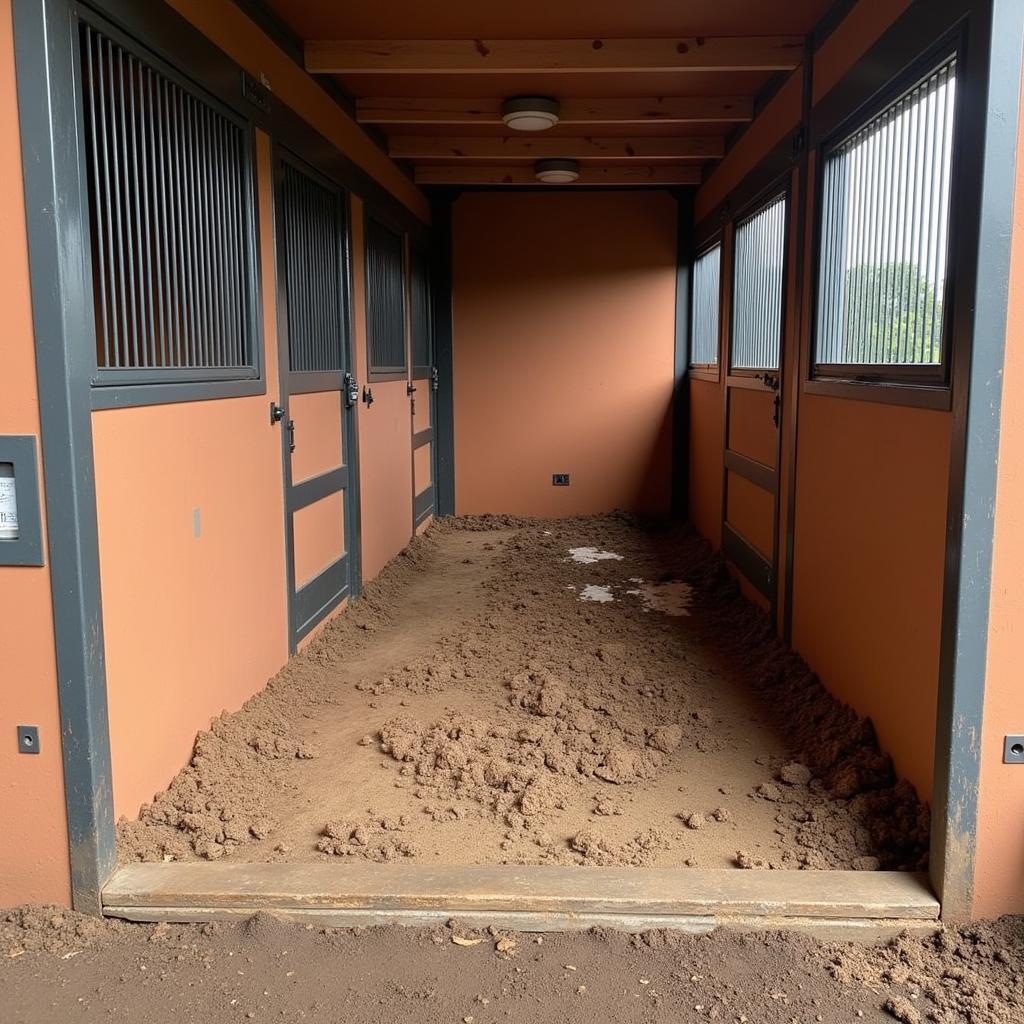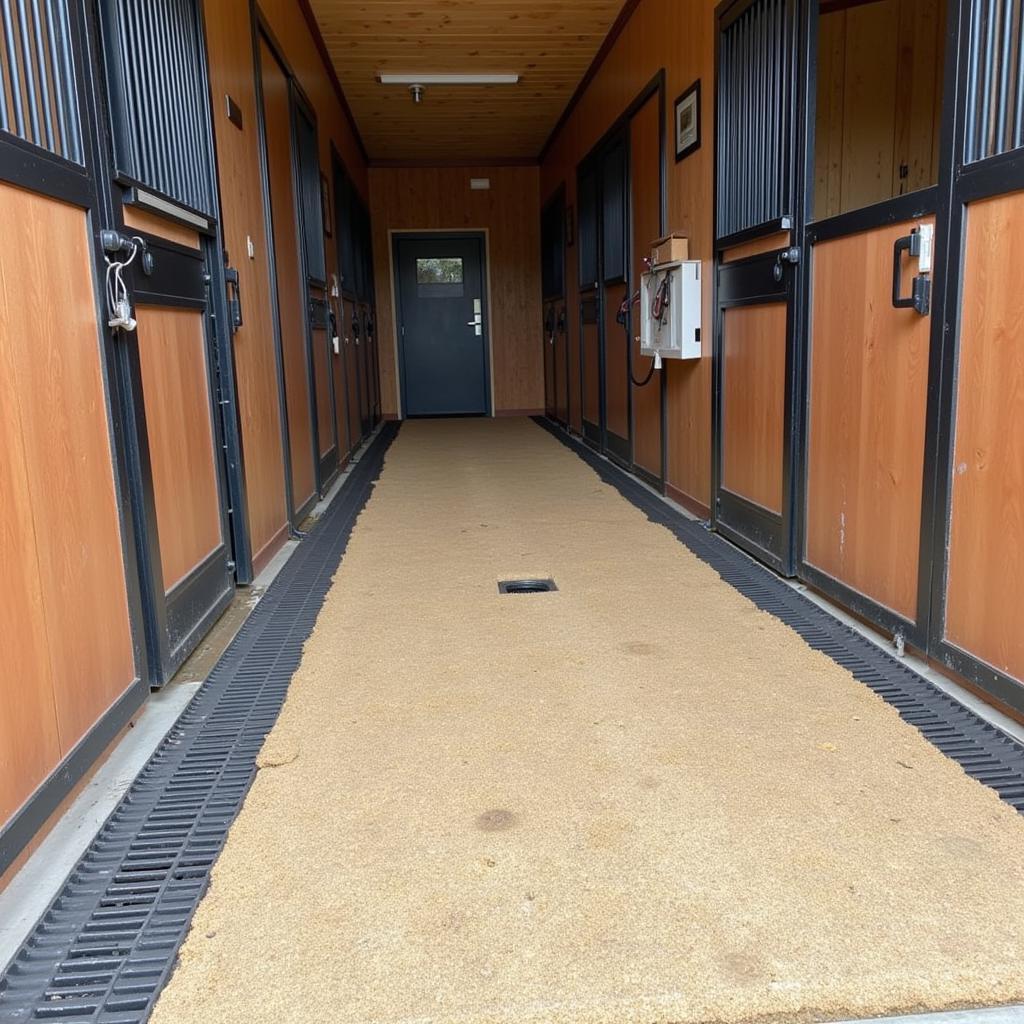Choosing the Best Flooring For Horse Stalls is crucial for your horse’s health, comfort, and safety. It’s a significant investment that impacts their well-being and can even influence your stable management routine. This comprehensive guide will explore the various options available, helping you make the right decision for your equine companion.
Key Considerations When Choosing Horse Stall Flooring
Before diving into the specifics of different flooring materials, it’s essential to understand the key factors influencing your choice. What works best for one stable might not be suitable for another. Consider the following:
- Your horse’s needs: A senior horse with arthritis will have different requirements than a young, energetic horse. Older horses benefit from softer, more supportive flooring.
- Your budget: Flooring options range from budget-friendly to premium.
- Maintenance: Some materials require more upkeep than others. Consider how much time and effort you’re willing to invest in cleaning and maintenance.
- Durability: The flooring should withstand daily wear and tear, moisture, and the weight of your horse.
- Aesthetics: While functionality is paramount, the appearance of your stall flooring can contribute to the overall aesthetic of your stable.
Exploring Different Horse Stall Flooring Options
Let’s delve into the most common horse stall flooring options, highlighting their pros and cons:
Rubber Mats
Rubber mats are a popular choice for their durability, comfort, and ease of cleaning. They provide excellent cushioning, reducing stress on joints and offering insulation against cold concrete. horse mats for stables are specifically designed for the rigorous environment of a horse stall.
Concrete
Concrete is a cost-effective and durable option, especially for high-traffic areas. However, it can be hard on horses’ joints and requires adequate bedding for comfort. While easy to clean, it can become slippery when wet.
Wood
Wooden flooring can be aesthetically pleasing and offers good insulation. However, it requires regular maintenance and can be prone to rotting or damage from urine.
Clay
Clay is a natural and absorbent option that can provide a comfortable surface for horses. It requires regular maintenance to prevent it from becoming too hard or dusty.
 Clay Flooring in a Horse Stall
Clay Flooring in a Horse Stall
Poured Rubber
Poured rubber provides a seamless, cushioned surface that’s easy to clean and maintain. While more expensive than mats, it offers superior durability and can be customized to fit any stall size.
What is the Easiest Horse Stall Flooring to Maintain?
Rubber mats and poured rubber are generally the easiest to maintain, requiring minimal cleaning and offering good resistance to moisture and wear. Concrete is also easy to clean but requires more bedding for comfort.
classic equine horse stalls are often designed with ease of maintenance in mind, incorporating durable and easy-to-clean flooring options.
How Do I Choose the Best Flooring for My Horse Stall?
Consider your horse’s individual needs, your budget, and the level of maintenance you’re willing to undertake. Consulting with a veterinarian or experienced stable manager can provide valuable insights.
What About Drainage?
Proper drainage is essential for any horse stall flooring to prevent moisture buildup and bacterial growth. Ensure your chosen flooring allows for adequate drainage or incorporates a drainage system.
 Horse Stall with Effective Drainage System
Horse Stall with Effective Drainage System
“Proper stall flooring is an investment in your horse’s long-term health and happiness,” says Dr. Emily Carter, Equine Veterinarian. “Choosing the right flooring can significantly improve their comfort and reduce the risk of injuries.”
“Don’t underestimate the importance of regular maintenance, regardless of the flooring type you choose,” adds John Miller, experienced Stable Manager. “Regular cleaning and upkeep will extend the lifespan of your flooring and ensure a healthy environment for your horses.”
Conclusion
Selecting the best flooring for horse stalls is a vital decision that impacts your horse’s well-being. By carefully considering your horse’s needs, your budget, and the various flooring options available, you can create a comfortable, safe, and healthy environment for your equine partner. horse tiles might be another option worth considering for their durability and ease of installation. Choosing the best flooring for horse stalls ensures a happy and healthy horse.
FAQ
- What is the most durable flooring for horse stalls? Rubber mats and poured rubber are generally considered the most durable options.
- What is the most affordable horse stall flooring? Concrete is often the most budget-friendly option.
- What is the best flooring for older horses? Softer materials like rubber mats or deep bedding over a suitable base are best for older horses.
- How often should I clean my horse stall flooring? Daily cleaning is recommended for all flooring types to maintain hygiene.
- Can I install horse stall flooring myself? Some flooring options, like rubber mats, are easy to install DIY. Others, like poured rubber, may require professional installation. pipe horse stalls can offer a sturdy framework for various flooring options.
- What are the benefits of using rubber mats in horse stalls? Rubber mats provide cushioning, insulation, and are easy to clean.
- What are the disadvantages of using concrete in horse stalls? Concrete can be hard on horses’ joints and requires substantial bedding for comfort. warmblood horse trailer requires careful consideration of flooring for comfort and safety during transport.
If you need further assistance, please contact us at Phone Number: 0772127271, Email: [email protected] or visit us at QGM2+WX2, Vị Trung, Vị Thuỷ, Hậu Giang, Việt Nam. We have a 24/7 customer service team.